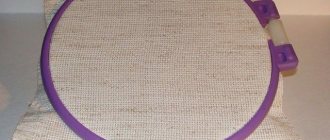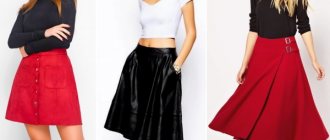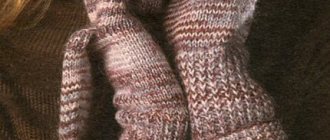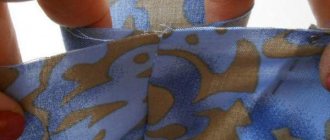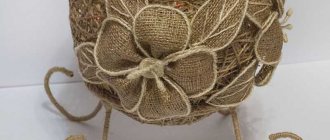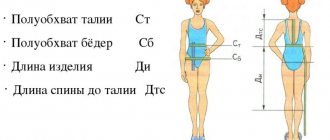You can learn how to embroider with satin ribbons on a variety of Internet resources, so there is plenty of information to easily learn the basics. In addition, modern society strongly encourages such types of needlework, offering a wide range of ready-made compositions with a full set of ribbons, needles, fabric and even designs. Every year more and more materials appear. Silk, satin, lace and synthetic are used. By weaving them together, we can create amazing compositions that are distinguished by their realism. Modern ribbons are used to embroider on all types of fabric through which a needle can be pushed.
The quality of the satin allows you to work on leather if you make holes in it in advance. Unlike cross stitch, the stitches create a three-dimensional image that will certainly attract the attention of true admirers of beauty. Of course, at first it doesn’t always work out the way you would like, but be patient, every masterpiece begins with confusion. You will certainly be rewarded for your efforts and time spent with enthusiastic exclamations from your friends when they see your skill. Get creative by creating new stitches and inventing patterns. Having mastered the embroidery technique, you can easily turn your favorite hobby into a profitable business.
Handicrafts as an aid to development
This type of creativity is in demand not only among girls. It is perfect for both their modern mothers and advanced grandmothers. Each generation will find its positive sides in this hobby:
- development of fine motor skills and, as a consequence, mental formation
- spatial thinking
- imagination
- sense of taste and style
- diligence and hard work
- accuracy and attention
- perseverance
From a psychological point of view, it helps
- finding a way to assert yourself
- release of energy through the hands
- finding inner harmony
- making friends with similar interests
Such skills develop the child and fill the hearts of the older generation with joy. And working together unites all family members.
To create leaves
- Take a green ribbon, it should be wide. To begin with, measure out five pieces of seven cm and six pieces of four cm.
- Cut out circles that will serve as the basis for the sepals.
- Fold 1 half of the leaf, turning it inward with the edge. Using a needle and thread, pierce the petal where the edge is folded.
- They do exactly the same on the other side, but in this case they bend the edge.
- The petal is collected a little and secured with threads where the edge is.
- The sections of the leaves are folded in two and the leaf is cut out. The edges are scorched.
- Take the wire, it will be needed for fastening. Before this, the edges of the petal are smeared with a glue gun, the first petal is taken and wrapped around the end of the wire, and the others in turn, around the first petal.
To clearly fix the rose on the wire, turn the rose over and fill it with glue until it cools completely, at the end of the work the sepals and petals are glued.
Ribbon embroidery for beginners step by step
Any beginner girl can decorate her home and make it cozy. Step-by-step lessons of this art will help you master this technique. The result of the training will delight you and your loved ones. Beginning needlewomen need to adjust the stitches when embroidering a picture. The technique of making amazing paintings amazes many and they eagerly want to try to make a hand-made masterpiece themselves.
You need to purchase beginner's kits from a craft store. It includes the training sequence, diagram and all necessary accessories. To get started as a beginner, you first need good light in the room where you are going to practice this art. Also a chair and accessories where everything will be at hand. So, you need to purchase the necessary accessories for needlework.
Materials and tools for beginners, prints and patterns
Detailed videos about embroidery are available on many Internet sites. They can be very different; they are chosen not only by color, but also by density. Silk, for example, is comparable to all types of fabrics; embroidery can be done with them even on leather, if, of course, you pierce holes in it with an awl in advance. The disadvantage of this type of linen is its high cost and the shedding to which it is subject after washing. Satin ones are considered the best option. They are washable, do not fade or fade in the sun. They can also be ironed at any temperature. The peculiarity of satin ones is their versatility; they are universal and suitable for making floral motifs and plots.
Features and varieties of satin ribbons
In order for a craftswoman to create her own little masterpiece, she needs to choose the right working material. Satin ones are offered in polyethylene packages, which indicate the thickness, its color, length and number. The beauty of them is that they have a huge number of color shades. There are so many of them that sometimes it is impossible to find out the desired shade without a number. Satin ones are very smooth to the touch and have a pleasant shine; due to their softness and pliability, they can be used anywhere.
When working, it is important to remember about the needle, because if the eye is too small and the tape is too wide, you will not only wear out your product, but also risk damaging its integrity. The material is very delicate and the slightest snag can cause the tape to begin to bristle. Among other advantages we can note:
- high strength
- durability of use, shine lasts for several years
- perfectly absorbs moisture
- not electrified
- drapes well
There are a huge number of positive aspects; satin ribbons are very affordable, which makes them popular among embroiderers. Your hobby will allow you to save money, because by creating a painting, you update your interior without significant costs. Many needlewomen insist that silk is better to use, but their cost is prohibitive for beginning craftswomen. In addition, it is better to study using the economical option, because you risk ruining expensive material without finishing the picture.
Choose silk or satin, the difference between these types of fabric
Silk is a natural material, and satin is synthetic. It wrinkles very much, so it should be stored in neat skeins; as for satin, it is less sensitive to bends. In addition, silk is prone to shedding and fades in the sun, unlike satin. General information combination of fabrics with satin: Satin (satin) is combined with lace fabric, velvet, chiffon, organza. Silk is combined with openwork fabric, velvet, jersey, organza, panne velvet, satin, chiffon.
Summing up the advantages of satin ribbons
If you decide to choose this particular type for your work, rest assured that this type of needlework will bring you an extremely pleasant experience and will take a minimum of time. The fact is that this type easily lays on the fabric, but if you encounter a problem with the rigidity of the tape, then simply wash it with conditioner.
For beginners, embroidery can be done with material of different widths, it all depends on what kind of pattern you want to depict. Embroider with thin satin strips; they pass through the canvas more easily and do not distort the design. Also, from wide diameters, overhead components of the picture are made - flowers, stems, leaves, bows. It is important to sew them on with hidden stitches, giving your work even more sophistication and originality. Add variety by making the composition three-dimensional by winding a thick ribbon onto a needle and forming French knots. This embroidery method is one of the key ones in the work. Satin ones are made from polyester fibers, which is why they hold their shape so well in compositions.
If you are interested in embroidery, you will find patterns on many online resources or download them from us. As most people say, roses are the best; with their brightness and even petals they will add elegance to any picture, and in addition, they look quite realistic. It is very easy to make roses from satin ones. You will see this for yourself by making several loops through which the tape is passed. This must be done in such a way that it passes either under the loop or above. The result is a bud that looks like a spiral.
Read more: rose and other flowers master class
A vine made of dark purple ribbons looks no less impressive; it is also simple to perform - when the needle enters through the outline, the needle is wrapped around the ribbon and pulled along the entire length through the resulting curl. Make several knots and add straight stitches in green, so you get a grapevine. There are many more embroidery options, which you can familiarize yourself with on the website, where stitching techniques are laid out in a simple form.
Features of the Kanzashi technique
A real art is figured weaving from ribbons, which has become widespread among craftsmen and needlewomen. Currently, several basic techniques are used to create original crafts:
- Making flowers from nylon ribbons.
- Making flowers from satin ribbons.
- The art of forming various figures from silk squares.
- Decorative design of miniature figures made from special quality rolled paper.
Japanese technology quickly gained popularity due to its beautiful patterns and ease of finishing.
Learning to embroider with ribbons like a pro, tricks small and large
Any type of needlework has its own tricks that allow you to quickly get the job done or correct minor flaws. Experienced craftsmen are well acquainted with all the intricacies of the work, but it will be very useful for beginners to learn advice from specialists.
- When embroidering leaves, you need to twist them around the needle once and make a straight stitch.
- if you need to make a large element with the needle twisting, then it needs to be securely secured with threads, and it will not subsequently unravel.
- It is recommended to iron from the wrong side. The same applies to the finished work.
- Don’t forget to burn the ends with a lighter; if you don’t do this, the weaving may unravel and instead of a beautiful flower, you will have a scrap of thread.
- If you frame it, it is recommended to insert glass from the front side so that dust does not settle on the ribbon. If you do not have glass available, replace it with plastic film.
- If you use a white canvas or light-colored fabric as a basis, you need to check the ribbons before work; they should be soaked a little. There is a risk that they will turn out to be of poor quality and will leak paint, thus ruining the material.
By adhering to these rules, you will be able to keep yours in good shape for a long time. Don’t worry if something doesn’t work out, even experienced needlewomen once started with straight stitches and extraordinary knots. Over time, you will master the basics of needlework and will be able to give advice to beginners.
If you want to keep up with the times, but at the same time appreciate old traditions and entertainment, it is a good idea to learn satin embroidery yourself. Everything is quite simple - you need ribbons of several color options, scissors, fabric and a needle with a wide eye. When mastering the basics, you need to become familiar with three types of seams; in the world of needlework, they are usually called stitches. There are 21 types of stitches in total, although skilled needlewomen are coming up with their own methods every day and creating unique masterpieces. To create a simple pattern, simply use a straight stitch, pulling a needle and ribbon through the canvas. Be sure to burn them at the end with fire, as a result they will not unravel. It would be very sad if you spend two days and everything collapses at the slightest touch.
Read more: stitches or embroidery stitches
Fabric (linen, cotton, double-thread, silk, satin, gabardine) for the base
For beginners, it is better to first start needlework using a ready-made drawing-scheme. The fabric can be any. This way you will understand later what density of fabric you need to take for a particular painting. For example, gabardine is very convenient because it is a pleasant synthetic material, it has a very good weave of threads, holds the ribbon, and the needle passes through the fabric easily. Also use silk fabric, cotton, satin, linen, and woolen fabric. It is necessary to take into account the size and weight of the painting; the density of the material is important; reliable fixation of the stitches depends on it. At the beginning we will work on a tight basis. If you are a beginner, then to get an even and smooth drawing it is better to use a canvas.
Hoops (round, square - from small to large)
The peculiarity is that the entire area of work must be in a hoop, the fabric must be well stretched. There should be no pinches or bends. Such an accessory for needlework must be selected in relation to the size of the painting. Hoops can have different shapes, such as round, rectangular, square. It is advisable to make three-dimensional paintings with a wooden hoop, and for small still lifes round plastic hoops are suitable. When choosing them, give preference to larger sizes so that the entire design fits into them. When the canvas is tightly stretched, then it will be easier to sew.
Different types of needles (tapestry, embroidery and beading)
The main tool is needles. There are tapestry needles that have a wide, elongated eye with a sharp end. It is important that the ribbon can be easily pulled through the eyelet, so select the number of needles according to the width of each. If the width is from 2 to 3 mm, then a needle with number 24 is selected. For from 7 mm to 12 mm, a needle with number 18-22 is suitable.
Long and thin bead needles are also used simultaneously in needlework. After all, not a single craftswoman can resist adding all the beauty of the product and expressing the idea with beads and seed beads. Embroidery needles are also suitable; you can use them to manually embroider certain areas of the picture (petals, stem or pattern). A useful accessory are sewing pins for securing fabric, or for fixing ribbons or petals.
Thimble, scissors, marker, lighter and awl
A thimble is simply irreplaceable when working with thick fabric. For safety, so as not to injure your hands when pushing a needle, always use this little thing; it should be present in all manual work. An awl is a necessary accessory. When creating a unique masterpiece on thick material, sometimes you need to stretch a wide ribbon through the fabric. And here an awl will be an assistant, with the help of which you can carefully push apart the interlacing of threads, without any damage to the structure of the fabric. To ensure that your work looks at the highest level, purchase sharp, comfortable scissors.
You need to cut on both sides. One tip is cut straight, which will be pulled into the eye of the tapestry needle, and the second - at an angle of 45 degrees. It needs to be burned with a lighter. Such tools should always be with you. It is also worth purchasing special markers if the work will be done in your own design. They are very diverse - some disappear in the air after two days, others disappear in water. They are very convenient for carrying out the ideas of your creativity.
Ribbons (satin and silk)
If you want to make your dream masterpiece come true in the form of a painting or interior decoration, you need to stock up on many different ribbons. A wide variety of handicraft items can be easily purchased in specialized stores. They come in different widths - from 2mm-13mm and of course have a variety of colors. It is better to start trying to work with satin ones, which have the peculiarity that they are dense in structure, do not wrinkle, matte on one side and shiny on the other, which later gives a zest. If you want to convey a more natural texture of a flower, it is better to use silk, because they are neither softer nor more manageable. There are also organza, nylon, transparent voile, and corrugated. This type of accessory is used on a wider scale. Any composition and your imagination will enrich the composition of the bouquet, creating the effect of airiness and liveliness.
Threads (floss, wool, iris, grass)
Threads are needed to secure the stitches on the front side, and on the back side to secure the ends of the ribbons. They also complement the decor in the design, or combine with cross stitch. The most common type is silk threads. The next one is floss and iris threads, in a variety of shades of color. They are used in the form of petals, grass, and inflorescences. There are well-known threads - grass (very similar in appearance to natural grass), with its help it is possible to create entire bouquets. Also used in embroidery are wool, thin or thicker yarn, it all depends on the composition you are creating. This type of thread gives volume to the painting, fills voids, and is an additional decoration for the craftswoman’s improvisation.
Beads and beads
The use of beads and seed beads is not superfluous. They decorate the creation; you just need to use your imagination and you can get a unique illustration of the work. They have different shapes and colors. Everything is selected individually to the type of drawing. It is these handicraft accessories that will reveal and add zest to your inimitable masterpiece. Many craftswomen really like to use beads in embroidery.
Nowadays, this type of needlework is a popular and exciting activity. It brings benefits and pleasure at the same time. This activity provides an opportunity to relax psychologically and switch from external problems to pacification of the internal state. After all, DIY creations inspire us to be kind, gentle and loving towards our family and friends. Don't be afraid to take on different new hobbies.
Master class for beginners
It will not be difficult for a needlewoman to learn how to embroider and knit flowers from ribbons. The first jobs should be simple . Creative individuals can come up with a sketch on their own, but the Internet is replete with step-by-step embroidery patterns with satin ribbons for beginners.
Preparing for work
A suitable diagram is printed and transferred to tracing paper . It is sewn to the base and torn off. The work is done along thread lines. You can attach tracing paper to the base and repeat the contours by pressing with a needle, without allowing the base to tear. The pressed lines are outlined using chalk or soap.
It has become much easier to transfer drawings with the appearance of markers that disappear after washing or on their own after 48 hours.
Some needlewomen, when looking for patterns for embroidering flowers with ribbons for beginners, take as a basis the canvas from bead kits with existing designs or fabric prints.
Ribbon embroidery for beginners step by step lessons
So, the first thing you need to do to get started is thread the needle and secure it. And only then begin to study the types of stitches.
Securing the tape
We take a thin 6mm and pull it into the eye of the needle. Now it needs to be secured. Place the tip of the needle on the edge of the ribbon, stepping back 1.5 - 3 cm from the edge, and make a puncture.
Next, you need to lower it to the end of the eye of the needle and pull it down - a knot has formed.
And the final stage of fastening, when starting embroidery, you need to fasten at the very end. We take the end of the tape and wrap it twice, about half a centimeter each, and pierce it. By stretching the needle to the end, we get a knot.
Video tutorials on making flowers from ribbons with your own hands
Rose made of satin ribbons
Description of work:
- Burn a piece of tape with a lighter on both sides.
- Fold the ribbon in half (lengthwise), then in half again. Roll the end of the folded tape into a roll and secure with thread. This will be the center of the rose.
- Sew the center to the felt.
- Randomly form folds from the ribbon folded in half and hem them around the center.
- Hide the end of the ribbon under the rose and hem it.
- Trim any excess felt around the rose.
The video should load here, please wait or refresh the page.
DIY ribbon daffodil
We will need a satin ribbon of three colors: white wide 4-5 cm, yellow and green ribbon narrower.
The video should load here, please wait or refresh the page.
DIY violets made from satin ribbons
Step-by-step master class on making Violets in a pot from satin ribbons. These flowers will decorate the interior of your home, do not require watering and will never fade. Such interior flowers will be a wonderful gift for mothers, grandmothers, and teachers on March 8th.
MATERIALS FOR MANUFACTURING THE ENTIRE COMPOSITION:
- pink satin ribbon 1.3 cm wide (≈ 4 m);
- green satin ribbon 5 cm wide (≈ 60 cm);
- decorative yellow stamens;
- wire with a cross section of 0.4-0.5 mm;
- tape;
- decorative pot;
- gypsum + water;
- sisal;
The video should load here, please wait or refresh the page.
Stitches, seams, loops, knots, main varieties
- Entwined straight stitch (hereinafter abbreviated as PS) and with attachments
- Herringbone
- Sliding classic and colonial knot
- Zigzag
- Cretan
- Spikelet
- Bow
- Bud classic, printed, convex
- Rococo knot
- Loop flower
- Chain stitch
- twisted rose
- Net
- Extended stitches
- Colonial Knot
- Basting tied in the center
- Twisted loop
- Zigzag basting
- Stem seam
- Seam grip
- Loop with attachment and straight stitch, with eyes
- half loops with classic and zigzag attachment
Of course, you can’t learn everything right away. The main thing is not to stop halfway and create a product step by step.
Read more about seams in the master class
To further master the art, you need to learn different types of stitches.
Because these elements make up flower petals, buds, stems and leaves. Also, some types of seams are used to finish a picture or embroider some kind of decoration. You can’t imagine how much stitches can transform your idea for a painting; you can embroider anything.
Loop stitch
This stitch is convenient for embroidering leaves and petals. Having secured it in the needle, we bring it from the back to the front.
Then, stepping back a little, we make a puncture, forming a loop:
And without bringing the needle completely to the wrong side, we pierce it closely in the center of the half-loop diagonally and bring it to the front part.
We stretch the needle and ribbon, adjust the loop and we get this element.
Then you need to make a puncture at the top of the loop to form a girth and get a bartack, that is, a “loop” seam with a bartack.
By tightening this fastening, it looks like a leaf:
Curl stitch
The next version of the leaves includes a stitch with a “curl”. They come in two types - straight and offset. An example of a straight stitch with a curl is very simple. We work with ribbon from 1cm – 1.5cm. We bring the needle from the wrong side to the front side and arrange it vertically evenly, straightening it.
Next, we make a puncture in the center of the ribbon and pull the needle through, straightening the loop.
Don't forget to carefully lay the curl.
Offset Curl Stitch
An example of a straight stitch - “offset curl” is also very simple in technique.
We also bring the needle to the front and lay the ribbon vertically
But we no longer make the puncture in the center, but along the edge of the edge on the right.
We stretch it, leaving a loop and we get a curl that is turned to the right.
It is also necessary to embroider this stitch with an “offset curl” facing to the left.
Twisted stitch
There is also the option of creating leaves and stems. It's a little simpler. The stems are made using a twisted stitch. The green one with a width of no more than 6mm is pulled onto the front one and scrolled until a certain spring is formed. Next, we insert it at the base of the bud on the wrong side.
2. In this way, a thin stem is obtained; if it does not hold well and moves along the canvas, secure it in the middle with ordinary thread.
French knot
The most common one in creating buds, as well as some other elements, is the French knot. They use it to embroider bunches of lilacs, grapes and even tree fruits. Having threaded the needle and secured it, we make a puncture on the front:
Next, we twist the needle so that it takes on the appearance of a spiral and wind it three or even four turns onto the needle.
And not far from the first 1-2mm puncture, we insert the needle on the wrong side.
The result is a beautiful lush knot that looks like a bead.
What stitches are used in ribbon embroidery
Ribbon embroidery for beginners is the most interesting activity, and this requires knowledge of all the stitches used. Before you begin, familiarize yourself with the most common stitches:
- Today, the regular straight stitch is very popular. It is the easiest to use. It is used for almost any type of embroidery due to its simplicity. If you pull the tape, you can independently adjust the stitch distance;
- Japanese ribbon stitches. In this case, the ribbon must be passed not only through the working fabric, but also through its own base. It is worth noting that when the puncture moves to the edges of the tape, needlewomen have the opportunity to achieve unusual effects while working. Feel free to experiment with different tensions to create uniquely shaped leaves and petals;
- Pre-fastened hinges. Ribbon embroidery for beginners is the most labor-intensive process. Needlewomen should learn exactly this method of creating a loop, because it is thanks to this seam that leaves, buds and various petals can be created.
Straight stitch
Japanese Ribbon Stitch
Loop with attachment
Sunflowers, daisies and other field bouquets
Embroidering flowers with ribbons, such as sunflowers and daisies, is quite easy for a beginner and therefore they are used more often than others in needlework. And this, in principle, is not strange, because a bright flower can attract everyone’s gaze and with its extraordinary beauty will transform even a dull room. In the modern world of HAND MADE, which simply means handicrafts, things are highly valued not only from an aesthetic point of view, but also from a financial point of view. A huge number of designers use it in the design of their clothing collections.
Painting sunflowers in a vase
Cushions, bedspreads and many decorative items fetch tens of thousands of dollars at auction. Floral motifs adorn the emblems of successful corporations and appear on promotional products. All this once again confirms that this type of art is not forgotten, but is just beginning its revival. Today we will try to learn together how to create bright pictures with these wildflowers using a master class from an experienced embroiderer.
Prints for ribbon embroidery of sunflowers on canvas
A sunflower is made in almost the same way as a chamomile, the difference will be in the length of the petals, their color and, of course, the middle. A sunflower petal is formed using the “turned seam” technique. You will need to pierce not only the fabric using an awl or needle, but also the parts of the ribbon that should lie on it. Thus, it turns out that the tip is slightly turned up. The petals on a sunflower should overlap, there should not be much space between them, 0.3 cm is enough. The middle is made with black French knots, they should resemble seeds that have already ripened in the sunflower.
Ideas and secrets in creating sunflowers for beginners
The history of embroidery
Scraps of satin have been used in everyday life since ancient times. Young girls braided them into their hair, and ladies decorated their hems with multi-colored ribbons. Later they became a sign of wealth. A noble lady had to have an embroidered dress in her wardrobe. In addition, they tried to decorate everything with satin: shoes, bags, interior items. One of the kings of France wore shoes embroidered with satin and precious stones.
Over time, the art of using satin ribbons to create unique images has spread throughout the world. Every girl, wanting to have an image that distinguished her from others, sought to decorate her wardrobe with unusual satin colors and compositions.
Nowadays, handmade paintings and icons are often used as gifts.
Required materials and accessories
Sunflowers must be started by collecting the necessary elements. And if you use a ready-made set, then it will be extremely convenient for you to do handicrafts. For girls who are encountering this method of needlework for the first time, we advise you to pay special attention to the selection of materials. The wrong fabric and threads can ruin several days of hard work. At the beginning of their careers, it is better for embroiderers to use wide-weave fabric. Tight material is difficult to pierce with a needle; in addition, holes often remain at the puncture site, which are then difficult to hide even with large beads. And a mandatory assistant for canvas is a hoop (round, rectangular, oval or square). Embroidery hoops are recommended for inexperienced needlewomen; they stretch the canvas well and simplify the work.
For needlework you will need:
- 12 mm thick yellow and 3 mm black
- green 24mm
- olive 15 mm
Try not to use lengths longer than 45 cm, as they will get tangled under your hands and prevent you from applying straight and twisted seams evenly. The optimal length is 30cm.
Needles
No less attention should be paid to the choice of needle; it must match the density of the fabric, otherwise a too thin needle simply will not fit or will get stuck in a dense fabric. There are many sizes of needles; tapestry versions with a wide eye are used most often. It is important that the ribbon can be easily pulled through the eyelet, so select the number of needles according to the width of each. If the width is from 2 to 3 mm, then a needle with number 24 is selected.
You also need to prepare scissors, a lighter, and threads in advance.
Necessary materials for work
Despite the abundance of trends and proprietary techniques, the materials and sets of tools used are approximately the same:
- Satin ribbons of various shades. To create flowers, you should take ribbons that are wide enough so that you can form beautiful petals and inflorescences.
- Scissors, threads, needles.
- Glue, glue sticks.
- Several tweezers.
- Decorative elements (beads, fishing line, sequins).
- A table lamp with a fairly bright light.
And, of course, stock up on detailed diagrams for work.
Petal embroidery technique
Embroidering sunflowers begins with the first thing you do is draw a diagram if you don’t have one ready. Place the flower on the canvas as you wish, but it is important to place large sunflower heads in the center of the picture, and smaller ones on the sides. A template like this:
For most beginners, the problem occurs already at the beginning - they are not able to properly secure the ribbon in the needle. To make the threading process less time-consuming, cut the edge diagonally. Next, insert it into the needle and pull it about five centimeters. Using the sharp end of a needle, pierce it at this distance and stretch along its entire length. This way you will have a well-fixed ribbon. Be sure to make a knot at the other end and burn it with a lighter, it will not come undone and your creation will not fall apart.
fixation
Embroider the petals with a “ straight stitch” in the direction from the center to the edge:
The technique is practically no different from daisies, only the middle is left larger. Wide ones tend to twist, so make sure that each stitch is placed evenly. You should not tighten the stitches too much, because the composition will bulge forward, and the canvas itself under the flower may unravel. It's sad if you spend a lot of effort and time, and it gets ruined by such stupidity. Remember that satin ones have a reverse side, which differs in texture from the smooth outside.
“Straight” they go around the flower in a circle and move to the middle. It will be done in black and a French knot, or rather knots, since there will be a lot of them. These nodules should resemble seeds that are already ripe.
french knot
On the finished sunflower, everything looks quite realistic and three-dimensional. Sometimes, needlewomen replace the black center with two shades of brown ribbons, making the same knots, but in two colors. There is a dark color along the edge, and a light shade closer to the middle. This choice is the author’s personal preference, so experiment as you please. Many argue that the more shades there are, the more spectacular the result.
We recommend craftswomen with extensive experience to make petals using Japanese stitches. This type of embroidery involves piercing not only the canvas, but also the base of the ribbon. When the puncture moves to the edge, quite spectacular images are obtained. If you want a uniquely shaped petal, you can also experiment with the amount of tension you use, just be careful not to overdo it.
How to learn to embroider with ribbons - instructions for beginners
You need to start learning just from processing the edges. After all, it’s a shame to master the basics and create a flower, and then, through negligence, burn it or melt it. If you can’t work with an open flame of a candle or lighter, then you should try alternative methods. For example, it is good to use the sting of a burning apparatus. It is quite possible that a wood burning device will be a more comfortable tool to use.
Did you manage to process the tape? Then it's time for the simplest embroidery for beginners. Aster or chamomile is an easy flower to make. We draw a “sun” on the fabric, take a thin white (for aster you can choose other shades) ribbon and thread it through a needle. We tie a knot on it, like on a thread, and put it into work from the inside out.
Let's look at it step by step:
- We sew a petal with ribbon from the center of the flower to the edge.
- It is convenient to sew the next petal in the opposite direction.
- So we fill all the petals, straighten the ribbon so that they look natural.
- We fill the core of the flower with yellow ribbon, threading it with many short, puffy stitches.
It is good to replace the stitches in the middle with Chinese knots, which are made in the same way as with regular thread. They come out of the ribbon more voluminously.
Poppies and roses are more difficult to make. You will have to cut out each petal from the ribbon and sew its inner edge. When the petals are ready, they should be joined with hot-melt glue or sewn with regular threads to match the color of the ribbon. Next, a flower is formed from the petals, planted on hot glue or sewn to the base fabric.
For a flower to look natural, it needs a pistil and stamens. They are easy to make from threads, you just have to work some magic on their ends. For example, poppies have black stamens with white tips. They can be made from black floss threads, the ends of which are coated with glue and carefully dipped in semolina.
It is good to decorate the tulip stamens at the tips with anthers made of dark beads. The main thing is to secure each bead on both sides so that it does not move from the end of the stamen to its base.
It is convenient to embroider narrow leaves of plants using a needle. The wide sheet will have to be made from tape separately, and then sewn to the canvas.
Thin stems can be embroidered well with thread, while thick stems can be made from twisted ribbon attached at equal distances to the fabric with thread of a similar color.
Stem and leaves
After completing the flower head, it is necessary to add a stem, as everyone remembers, this flower has a fleshy stem, so a regular longitudinal seam will not work. Perform with a twisted stitch:
It is better to take a wide one for this, so that there is a three-dimensional “drawing”. As for the leaves, they are made with a straight stitch using a 24 mm ribbon. It works better than others for beginners. If you want to add realism, use iris threads to make several tie-ins to imitate the veins of a real leaf.
Video: learning to embroider roses with ribbons
How to embroider lilacs correctly
Before you begin, you need to prepare the following tools and materials: canvas or fabric with small holes for ribbons. For ease of work, you can take a hoop, frame, needles, threads to match the ribbons, as well as many other things.
Step-by-step technique for embroidering lilacs:
- The embroidery fabric is stretched onto a hoop or a special wooden frame.
- Using colored pencils, you can transfer the design onto the fabric, and you need to convey all the details of the pattern.
- Ribbons should be selected as carefully as possible.
- It is best to start with a lilac branch and edge. To do this, a large needle is threaded into the fabric so that its tip is only on the wrong side. After this, you can tie a small knot on the ribbon, which is best hidden.
- To embroider lilacs, you will need to thread the ribbon from the wrong side to the front side of the working fabric. Here you can remove the needle and silk thread. It is sewn only with small stitches across the work, after which you can make a few stitches along the edge of the tape.
Ribbon embroidery from A to Z will open for you new horizons of beautiful and breathtaking needlework! A flight of creative imagination will make this activity completely unique and inimitable every time.
Additional composition elements
At the end, iron the work and therefore fix the petals properly. It is very important to iron the product only from the wrong side. The thin texture can stick to the iron and the sunflower will literally burn. Most people do not complement the composition with other colors, considering it unnecessary.
It’s a great idea to highlight the composition using wildflowers and herbs. They must be made using the same olive iris thread. You will get a spectacular bouquet of wildflowers that will decorate any room in your home in the form of a picture and will certainly attract interest. And even more so if you decorate your coat or blouse with them.
Don’t be afraid to experiment and add something new to traditional techniques, this is how new directions appear in the world of HAND MADE. There are a huge number of specialized sites on the Internet where lessons for beginners will allow you to improve your skills and become a real professional.
There are countless different seams and stitches in needlework. See our sections on embroidery of various kinds of flowers and pictures. I wish you success and patience in creating masterpieces with your own hands! Have a good mood and inspiration.
Advantages of satin ribbons as a material
One of the main advantages of this material is its low price. It is due to the fact that sewing waste is mainly used to create ribbons, and the technology for their creation also does not require large expenses.
In addition, satin ribbons are an excellent material for creating crafts. They are sold in all sewing supply stores. In addition, anyone who has ever held a thread and a needle in their hands can work with them.
An important advantage of such an entertaining activity will be family time. After all, to make crafts you don’t have to attend any clubs; you can do handicrafts with your family, which will allow you to spend more time with your family.
In addition, making crafts from ribbons will teach your children how to handle sewing supplies and will have a positive impact on their personal qualities.
By regularly making crafts, your child will become more intellectually and physically developed. And step-by-step instructions will help you in making it, which clearly explain how to make such a decoration.
Child psychologists note that the following qualities become the most developed:
- Patience
- Perseverance
- Attention
- Accuracy
If your child is interested in painting or music, then such needlework will develop his fine motor skills, which will be very useful in these types of activities.
You can learn this entertaining handicraft at home by simply watching the video and photo instructions for creating jewelry from ribbons.
Making crafts from ribbons will also bring a lot of benefits to adults. You can use decorations for various celebrations. In addition, homemade ribbon decorations are valued much more than store-bought ones.
Dandelion
If you are already interested, then be patient and work hard to get a good result. Then you will gain victory and become the author of your own composition.
Initial stages
To begin, prepare a ribbon so that one edge is cut at an angle of 90 degrees and scorched with fire, and the second end is cut obliquely - this is what needs to be inserted into the ear:
It is important to learn how to pin. One of the edges, cut at a right angle, needs to be folded by about 3 mm and then, piercing it, you get a knot:
If everything works out, start creating. All information, diagrams are on the Internet or in the store. Ready-made ideas from professionals will be a godsend for beginners.
How to quickly thread a ribbon through a needle
Ribbon embroidery for beginners is the study of a technique that will allow needlewomen to quickly learn how to thread ribbons through needle loops.
- Cut the edge of the ribbon diagonally and thread it through the hole of the needle. Move the needle at a distance of at least five centimeters;
- Next, you will need to pierce the tape with the tip of a needle at a distance of 5 millimeters from the edge;
- The next step is to pull the tape, which should be moved along it until a knot forms on the ear;
- After completing all the steps, the tape will be securely fastened. Needlewomen will be able to start working.
Useful tips
The path to a masterpiece always begins with basic knowledge. Throwing simple loops, knots, and cobwebs is the basis of the most complex technique. For example:
cobweb
Take a separate piece of fabric and practice securing and making straight stitches on it. I would like to mention the “Japanese stitch” method. There is some similarity here with a straight seam. Its peculiarity is that it passes through itself and through the fabric. First you need to pierce the tape itself, and only then the base. In this way we obtain original compositions of flowers and leaves:
japanese stitch
Experiment. Let the flowers fall on the material with voluminous airy buds, and small thin petals sparkle on the canvas with the smoothness of silk threads. Butterflies, dragonflies and bees will not only add naturalness, but also breathe life into it.
What materials are needed
Purchase the following materials from a specialty store:
- Satin ribbons
- Needles with a wide eye
- Fabric with hoop as base
- Scissors
- Beads as decoration
- Matches (burn the ribbons)
- Pencil
We embroider dandelions
Working with a dandelion image is quite easy. Such a simple creation can become the first in your photo gallery. To draw the diagram, use a thin, discreet pencil so that the original sketch cannot be viewed on the finished work.
scheme
It is advisable to choose dark material. This will give clarity to your drawing. Fix the material tightly with a hoop and transfer the image. Its traces are faintly visible on a dark background, but this will be enough to work with the general outlines of the drawing. If desired, transfer the dandelion drawing in another way: cut out a paper sketch of the flower and apply it to the fabric. This technology for transferring all the details of an object is much simpler:
Lily
To create a lily with your own hands, you will need white satin ribbons, so let’s look at the creation steps:
- Eighteen pieces are cut, the length is 6.5 cm. Putting them together, cut out a petal for the lily according to the template.
- Burn the edges, holding the front side away from you.
- They form veins on the petals, use a knife on the non-cutting side for this, draw veins in the amount of six.
- The petals of the 1st row are attached to the finished base of 4 cm, which is made by folding the ribbon in two.
- The petals of the 2nd row continue to be glued, and the 3rd row consists of six petals, it is left for a while.
- Collect the beads on a fishing line, spray 2 rows with varnish, while straightening them.
- When the varnish is dry. Glue the last row, stamens.
Our lily is ready!
Embroidery technique
Now let's take the base. Select threads of a suitable color and sew straight seams along the outline of the intended pattern. The tape is displayed on the front part. You need to wrap it around each seam prepared in advance, that is, we pass under the straight stitches made. The method allows you to get a narrow twisted stem in the future picture:
3. Japanese stitch is used to form leaves. We pick up the bottom edge and form a straight stitch. You should get a pointed leaf:
4. We begin to create the seed umbrellas of our dandelion. We embroider with white according to the principle of the stem, and it is better to display the white hairs with ordinary sewing thread.
5. We embroider the second dandelion, which has already bloomed, in yellow and use the Japanese stitch, around the flower:
6. And at the conclusion of our creation process, the last element remains - the jagged leaf. Advice: cut out the leaf yourself from a wide one and sew it on, or not cut it out. For example, from a narrow green ribbon we make a straight long stitch from the stem twice, so that between them there is, as it were, a leaf vein. Then, using a dark green thread, we will create a natural look for these veins:
Use your imagination, change the size of the stitches, try to achieve accuracy in your work and not clutter it with unnecessary seams:
Decorate the finished product with beads. This way you will add originality and originality to your creation. Imagine!
Advice from experienced needlewomen
- It is necessary to notice tape twisting in time, so when carrying out work you need to pay attention to the back (matte) and front (sides)
- When making the stem, twisted stitches are made. It is advisable to fix them along the length with hidden stitches
- Before embroidering, iron all ribbons using moisture.
- If the painting is done on a high-density canvas, then you need to make the figures manually or on a machine
Today, embroidery with ribbons is one of the best options to pass the time and beautifully decorate many things.
